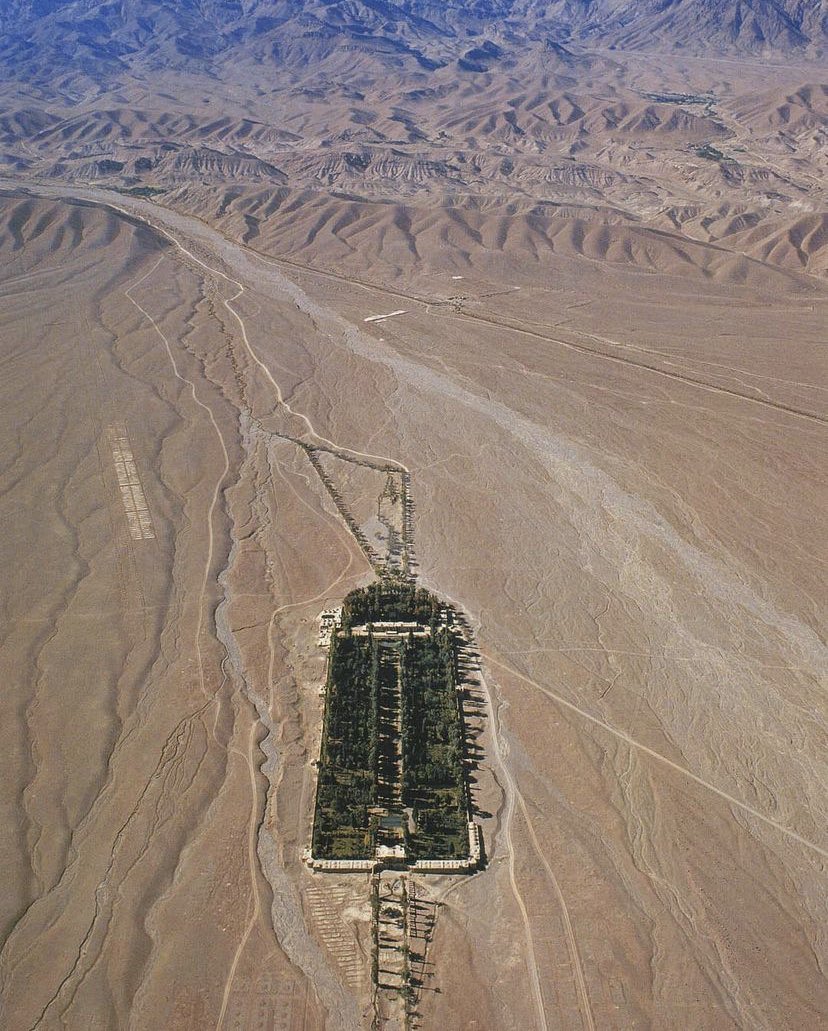The walled garden, qanats and the paradise
Contributor
Reciprocal Landscapes
The sun has no mercy. Neither does Iran’s central desert. You remind yourself about the margins to get out of Bagdad. But now surrounded by the never-ending dunes of beige: Was it worth leaving India? You are sure that you are going to die. Why wouldn’t you? Not even a single flower can find water to sustain the harshness of this climate. Out of desperation, you push your horse to gallop as fast as it can. Suddenly, your horse almost falls into a hole, throwing you off while trying to stabilize itself. Laying down on the ground, with a feeling of defeat, you close your eyes and accept destiny. The sound of water is in your ear. You scream while violently heaving yourself up. Only now do you realize that it is not a hallucination. Water flows below the hole. And it seems to be a canal, as the hole is followed endlessly by the next one. You get your horse up and ride. It takes you several kilometers until you reach a giant Gate. The gate slowly opens. You have reached paradise.
The ethnologic roots of the English word “paradise” originated in an old Persian word for enclosed pleasure grounds, referencing the ancient leisure garden of Persia. Their successors, like the beautiful Shazdeh Mahan Garden, besides still being visual paradises, are worth studying not only for their historical and aesthetic qualities, but more so because of their underlying geoengineering that created a biodiverse and inhabitable space in a rather arid and hostile landscape through their control of water flow.
Shazdeh Mahan Garden, situated in Kashan and on the edge of the desert in Iran, is one of the “Persian Gardens” named World Heritage Sites by UNESCO 2021. The garden, created in the 1850s by the Prince, is a unique interpretation of the “four-plot garden,” as it articulates architecturally its main features by overemphasizing them, for example, the irrigation system. Usually, these gardens are organized on a grid of plots, then irrigated and drained through a system of water channels flowing downwards following a slight decline inside the garden. Water is brought to the garden by qanats, ancient handmade underground waterlines. With a combination of shafts and horizontal expansion, the water system is either pulling inaccessible water out of aquifers or collecting water at the edge of the feet of mountains, using water that would evaporate otherwise.
This very specific space, articulated in a particular time and culture, is actually one of the finest examples of the walled garden, one of the two landscape architecture archetypes. It came to be due to the first permanent settlement in human history in the (semi-)arid climate of the Eurasian or North African region. As vegetation is not nourished on its own but instead through human intervention, the walled garden was a means to cultivate and protect the fragile state of plants in this environment by creating an enclosed habitat in which necessary needs like water could be provided. While the Persians made water accessible through qantas, Palestinians in Jericho did so by collecting water in cisterns, and Egyptians used the Nile as a source for irrigation.
But rather than being in Iran, Palestine, or Egypt, the basic underlying action of the ancient hydraulic civilizations is visible through all these means: creating biodiversity through human interventions. These techniques not only profited the hands who created them, but also benefited the environment through the diversification of landscape features. Water, shadow, and food are provided to both humans and non-humans. This concept of humans as a positive force in shaping the environment contradicts our current understanding, based in the 1970s. Around that time, the environmental movement came to be in the aftermath of the counterculture revolution of the 60s and took over some of their anti-mainstream sentiments. This resulted in the idea of environmental protection through isolating and conserving “nature” from the exploitative nature of humankind.
While the movement successfully created awareness about the climate crisis, it misses one of the key solutions for it: human intervention. As a case study, the Persian garden offers a more profound lesson beyond the very practical learning points such as low-tech irrigation techniques and gardening: its genius in geoengineering teaches us the need to identify the potential of a place, listen to the Earth, and generally treat resources as the rare treasures that they are. It shows that we have to work constructively rather than minimalistically in our environment if we want to turn a hostile desert into a rose garden. It encourages us to think not only about conservation in the face of climate crises but also about active change to create benefits for us and our surroundings in a non-exploitive way. It teaches us that if we act as humble gardeners for this beautiful place called Earth, we can recreate paradise.
